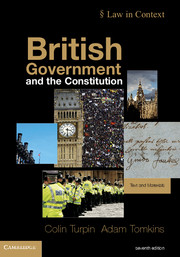Book contents
- Frontmatter
- Contents
- Preface
- Acknowledgements
- Abbreviations
- Table of Cases
- Table of Statutes
- Table of European Treaties
- Part I Constitution, state and beyond
- 1 The British constitutional order
- 2 The ideas of the constitution
- 3 Constitutional sources
- 4 Devolution and the structure of the UK
- 5 The European dimensions
- Part II Government
- Part III Accountability
- Part IV Liberty
- Index
5 - The European dimensions
from Part I - Constitution, state and beyond
- Frontmatter
- Contents
- Preface
- Acknowledgements
- Abbreviations
- Table of Cases
- Table of Statutes
- Table of European Treaties
- Part I Constitution, state and beyond
- 1 The British constitutional order
- 2 The ideas of the constitution
- 3 Constitutional sources
- 4 Devolution and the structure of the UK
- 5 The European dimensions
- Part II Government
- Part III Accountability
- Part IV Liberty
- Index
Summary
No successful account of the British constitution can now be confined to institutions, events or laws which are exclusively British. Over the past half-century, as the constitutional importance of the Commonwealth has declined, so has the significance of ‘Europe’ grown and grown again. ‘Europe’, in this context, denotes two international organisations in particular: first, the Council of Europe and its European Convention on Human Rights; and, secondly, the European Union. As was made clear in chapter 2, it is imperative not to confuse these two legal ‘Europes’ with one another. This is not least because the impact which each has had on the British constitution is different. In this chapter attention will first be given to the ECHR. We shall then go on to consider the nature and structure of the EU and the impact of EU membership and EU law on the UK.
The European Convention on Human Rights
The ECHR is an international treaty made under the auspices of the Council of Europe, which is based in Strasbourg in eastern France (a list of the principal rights protected under the Convention was given above, p 82). The UK was the first country to ratify the ECHR, in March 1951. The Convention came into force in 1953 and the European Court of Human Rights handed down its first judgment in 1961. From these slow post-War beginnings has grown an extraordinary and genuinely pan-European human rights regime. The Council of Europe now has forty-seven member states, all of whom are parties to, and are hence bound by, the Convention. This membership stretches from Iceland to Turkey, from Finland to Malta, and from Portugal to Russia. Ukraine, Azerbaijan, Armenia and Georgia are all members, as are all twenty-seven Member States of the EU.
- Type
- Chapter
- Information
- British Government and the ConstitutionText and Materials, pp. 277 - 362Publisher: Cambridge University PressPrint publication year: 2011

